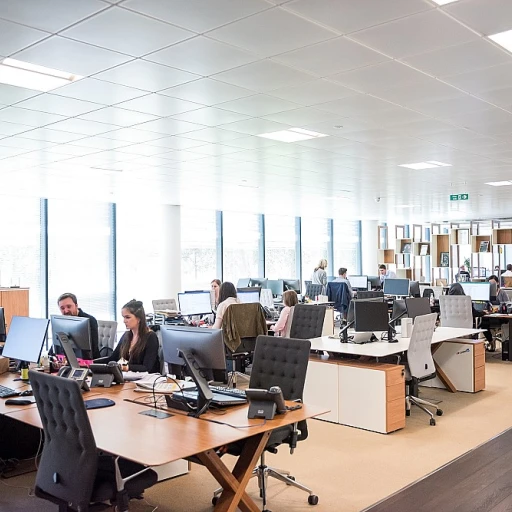
Understanding the Importance of a Well-Equipped Remote Workstation
The Benefits of a Comprehensive Remote Workstation
The shift toward remote work has underscored the necessity of a well-equipped workstation. For remote employees, the workstation is not just a place for productivity; it's a hub for collaboration, communication, and consistent output. Investing in the right setup can lead to significant enhancements in work performance and overall job satisfaction.
A thoughtfully designed workstation aids in reducing distractions and optimizing work hours. By ensuring access to quality devices and tools, remote teams can maintain the level of engagement and cooperation that was once confined to the office setting.
The Role of Technology in Remote Work
Technology plays a pivotal role in maintaining and improving the efficiency of remote workstations. By integrating the right software, monitoring tools, and time tracking systems, companies can ensure that remote workers remain productive. Tools that offer real-time engagement and desktop control can help in maintaining a secure and connected environment.
Moreover, management can make informed decisions by using data from employee monitoring systems and threat detection tools to assess employee activity. Understanding these dynamics is crucial in the larger context of team management.
In pursuit of enhanced work efficiency, businesses can also automate shift clocking systems to better manage work hours and streamline operations.
Essential Hardware Components for Remote Employees
Key Hardware Components for Remote Work Success
Having the right hardware is crucial for remote employees to work efficiently and comfortably from their home offices. The right combination of equipment can make a significant difference in productivity and employee satisfaction. Here's a glance at the essential hardware components that remote employees depend on:- Laptop or Desktop: While laptops offer mobility, desktops can provide greater processing power and upgrade options. The choice largely depends on the nature of the remote work and personal preferences.
- Dual Monitors: A dual-screen setup can significantly enhance productivity by allowing remote employees to multitask efficiently and keep multiple windows open without clutter.
- High-Resolution Webcam and Microphone: Clear video and audio are vital for effective team communication during virtual meetings, facilitating better collaboration among remote teams.
- Noise-Canceling Headset: This is invaluable for maintaining focus during work hours, especially in environments where noise can be disruptive.
- External Keyboard and Mouse: Ergonomic keyboards and mice can reduce the risk of strain injuries and improve comfort for remote workers integrating various devices into their workflow.
- Reliable Internet Connection: Ensuring a stable and fast internet connection is non-negotiable, as it impacts everything from video calls to access to cloud-based software solutions.
Integrating Effective Tech for Seamless Remote Operation
In addition to selecting sturdy hardware, optimizing remote workstations requires attention to the connectivity and support systems that tie everything together. Investing in proper network equipment like routers offering real-time data throughput and security measures can help mitigate potential disruptions. Remote desktop software can facilitate seamless access across different devices, promoting flexibility for remote employees. Considering the impact of pilon payroll on employee feedback also highlights the importance of accommodating diverse employee needs. Tailoring these setups to individual employee requirements can not only boost morale but also strengthen the company's overall remote work strategy.Software Tools to Enhance Remote Work Efficiency
Enhancing Efficiency with the Right Software Tools
Remote work relies heavily on the right selection of software tools to boost productivity and streamline operations. These tools not only facilitate communication and collaboration but also monitor employee activity to ensure that time-tracking and managing work hours are efficient.- Communication and Collaboration Platforms: Software like Slack and Microsoft Teams are essential for remote employees, helping maintain real-time communication and effective collaboration with the team. These platforms often include features for managing tasks and projects, aligning with the company's goals.
- Remote Access and Desktop Control: Tools that provide secure access to office systems, like VPNs or remote desktop applications, are crucial. They must also focus on data security and threat detection, ensuring that sensitive information and systems remain protected.
- Employee Monitoring Software: Incorporating monitoring tools that focus on employee monitoring and activity tracking can keep productivity in check without feeling invasive. They can track cls fill and stroke width, offering insights into how work hours are being utilized.
- Productivity Apps: Applications designed to aid in productivity help remote employees organize tasks effectively. Apps like Trello or Asana can be instrumental for project management, allowing teams to stay aligned and focused on objectives.
Creating an Ergonomic Workspace at Home
Designing a Comfortable and Productive Home Office
Creating an ergonomic workspace at home is vital for remote employees to maintain both comfort and productivity. Tailoring your remote work area to suit your body’s needs can reduce fatigue, prevent work-related injuries, and enhance overall efficiency. Start by focusing on your seating arrangement. An ergonomic chair that supports your back and encourages good posture is essential. Adjust the chair's height so your feet are flat on the ground, and your knees are at a right angle. A footrest can be helpful if needed. The positioning of your work devices, such as a laptop or desktop, also plays a crucial role. Ensure that the top of your monitor is at or slightly below eye level, and there’s about an arm's length of distance from your eyes. Seriously consider investing in a separate keyboard and mouse to position your monitor correctly without stressing your body. Desk height is another key factor. If you can, opt for a desk that allows you to alternate between sitting and standing throughout the day. This flexibility can improve circulation and reduce the strain of long work hours, enhancing your team's overall productivity. Lighting should not be ignored. Natural light is best, but if it's not possible, ensure your workspace is well-lit with ambient lighting that reduces eye strain. Consider using task lighting to illuminate specific areas as needed. Finally, personalizing your home office space with plants or meaningful artifacts can boost your mood and motivation. A calming and inspiring environment has a positive impact on productivity and well-being. Remember, to effectively manage remote work and maintain long-term health, regularly adjust your setup based on employee feedback and evolving needs.Security Measures for Remote Workstations
Ensuring Secure Remote Work Environments
For remote employees, maintaining a secure work environment is crucial not only for the protection of company data but also for safeguarding personal information. Implementing robust security measures can mitigate potential risks and enhance productivity.- Hardware Security: Remote work requires laptops and other devices with up-to-date security features. This includes biometric authentication and virtualization-based security, which ensure that only authorized personnel have access to sensitive information.
- Software Tools: Deploying reliable software solutions for threat detection and secure remote desktop access can significantly bolster a company’s defenses. These tools enable real-time monitoring of remote employees’ activities and help identify suspicious behavior.
- Encryption and VPNs: Encrypting data transmissions and using Virtual Private Networks (VPNs) are essential practices for protecting data flows between remote workstations and central company servers. This prevents unauthorized interception or breaches.
- Identity and Access Management (IAM): Implementing IAM solutions ensures that users operate under the correct permissions according to their roles. This minimizes the risk of unauthorized access to company resources.
- Employee Training: Regular security training can empower employees to recognize and respond to potential threats. Educating remote teams about common cyber threats like phishing and ransomware is a key component of an effective security strategy.
Gathering and Implementing Employee Feedback on Remote Setups
Leveraging Employee Insights for Optimal Setup
Collecting employee feedback is essential to refine remote workstations, ensuring they meet the evolving needs of remote employees and enhance overall productivity. Encouraging employees to share their experiences with the current setup, as well as their challenges and suggestions, can provide invaluable insights into making necessary changes.- Gathering Feedback:
- Analyzing Data:
- Implementation Process:
- Communication:












